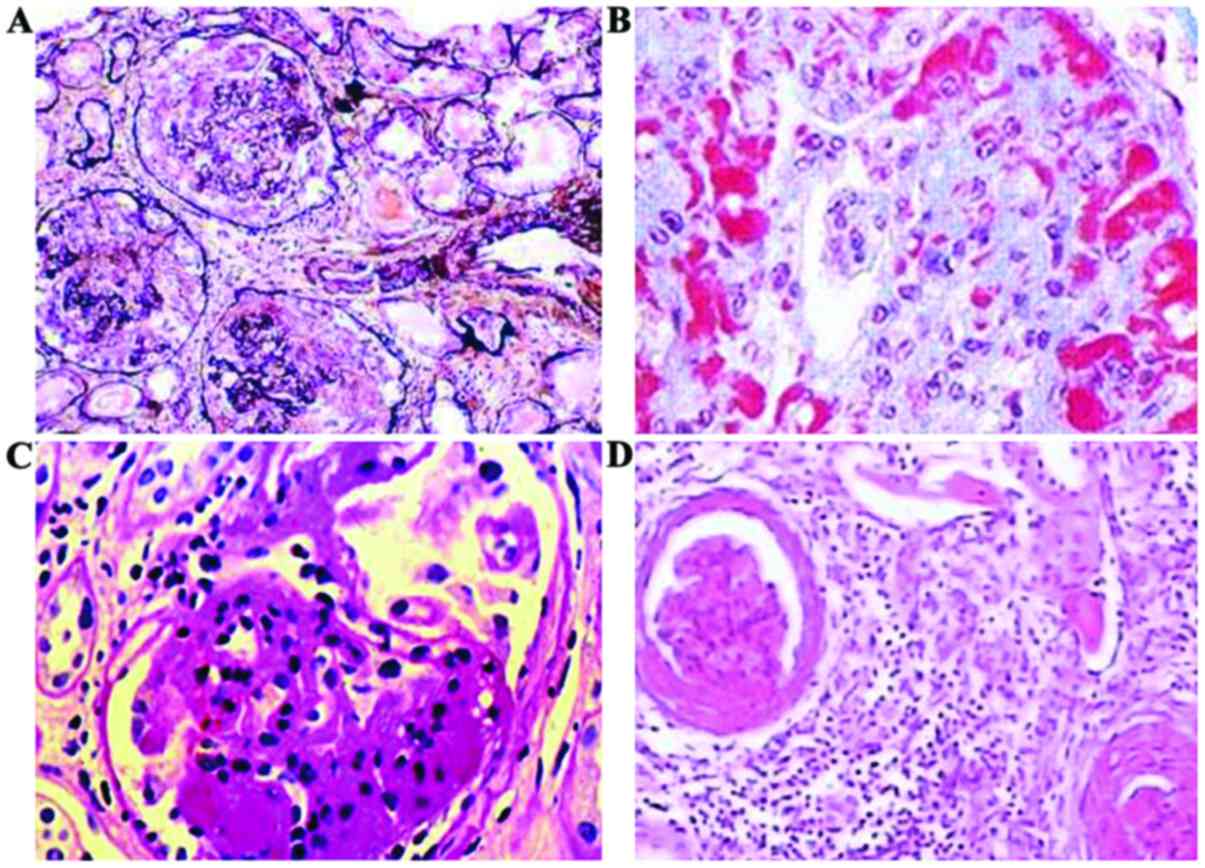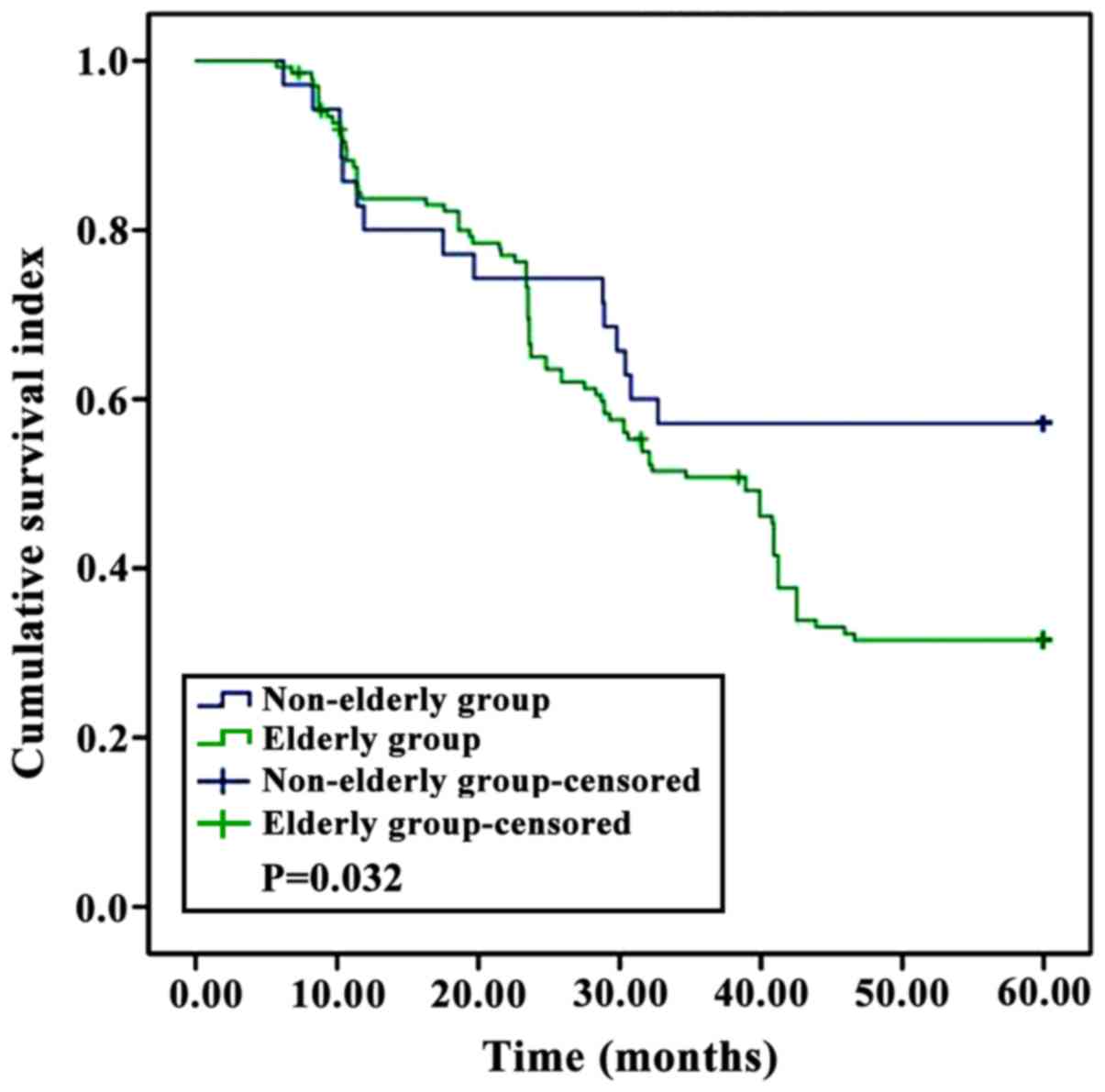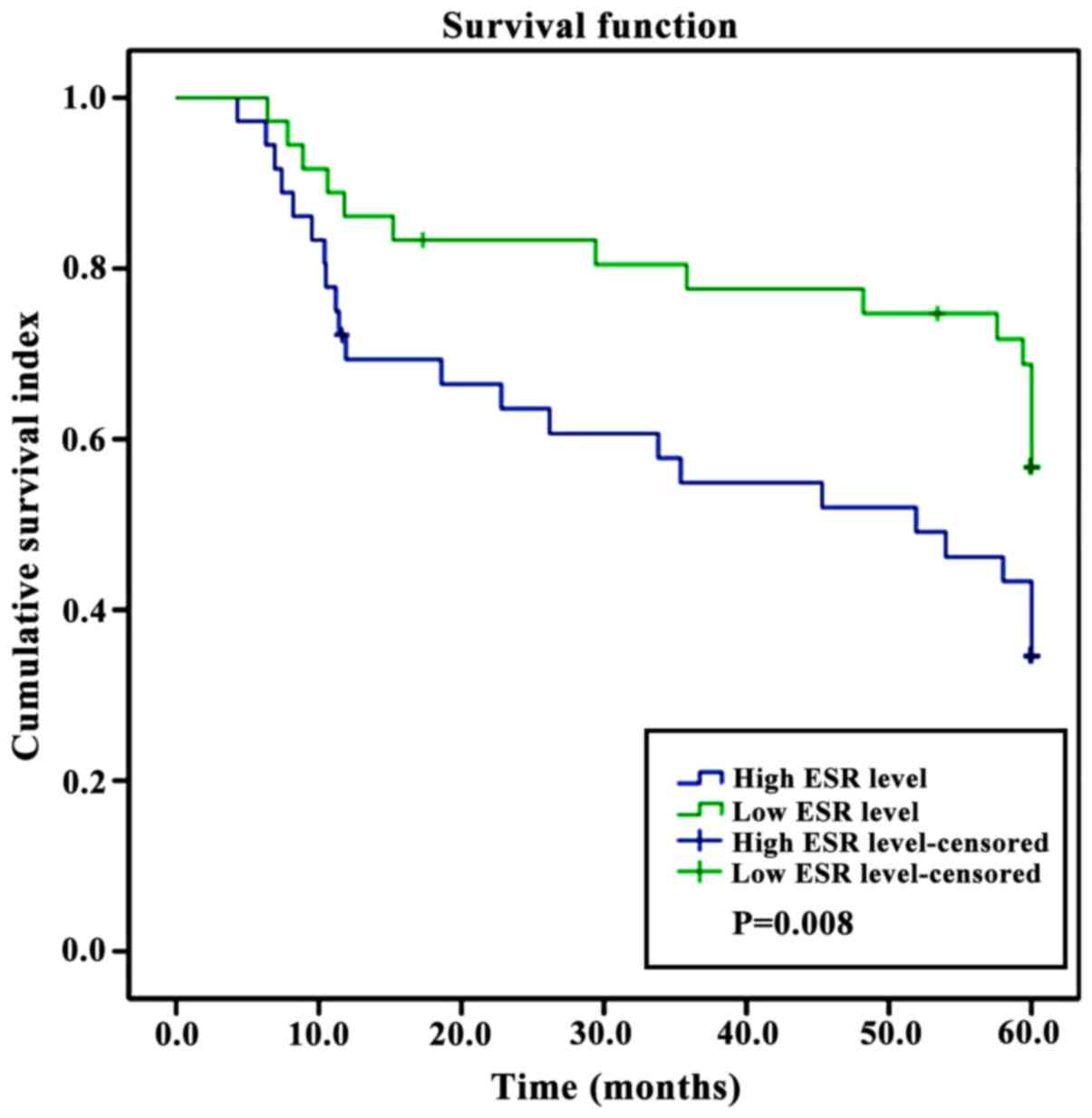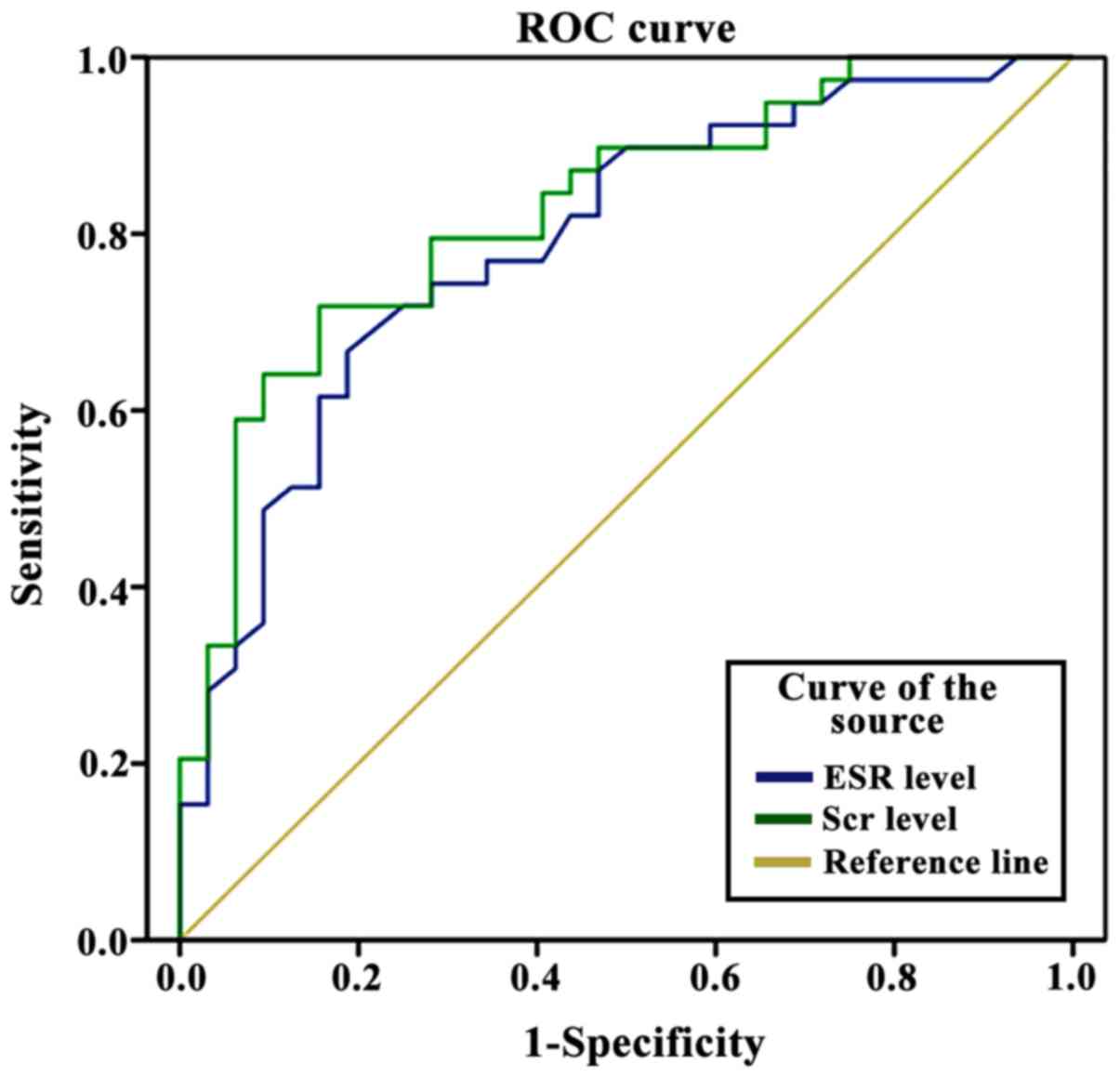Serum creatinine level and ESR values associated to clinical pathology types and prognosis of patients with renal injury caused by ANCA-associated vasculitis
- Authors:
- Published online on: October 16, 2017 https://doi.org/10.3892/etm.2017.5306
- Pages: 6059-6063
-
Copyright: © Liang et al. This is an open access article distributed under the terms of Creative Commons Attribution License.
Abstract
Introduction
Anti-neutrophil cytoplasmic antibody (ANCA)-associated vasculitis (AAV) is a common autoimmune disease with rapid progression, and is one of the causes of secondary kidney disease. The clinical symptoms of AAV patients are mainly fatigue, fever and emaciation (1,2). AAV often leads to multiple organ involvement, especially affecting the kidneys, altering glomerular capillaries and small arteries, leading to renal injury and causing focal necrotic glomerulonephritis, accompanied with crescent formation and renal insufficiency. Most importantly, the progression of AAV is rapid and the 5-year survival rate of patients is <60% in the absence of timely and effective renal replacement and immunosuppressive therapy (3,4). Creatinine (SCr) found in the serum is the product of muscle metabolism in the human body; it can be filtered by glomeruli and excreted in the urine. SCr is often used as a major clinical indicator of renal function (5). The erythrocyte sedimentation rate (ESR), or blood sedimentation for short, refers to the sedimentation rate of erythrocytes under certain laboratory conditions. In blood samples from a variety of pathological conditions, ESR is significantly increased, reflecting the activity of the disease to a certain extent (6). In this study, Scr levels and the ESR were measured in patients with renal injury caused by AAV, and the relationship between the values obtained and the pathology and prognosis of the patients was analyzed, so as to provide reference markers for prevention and treatment of AAV disease.
Patients and methods
General data
A total of 86 patients with AAV treated in the Affiliated Hospital of Qingdao University from December 2010 to November 2011 were enrolled in the study. Patients who met the following conditions were included: patients diagnosed with AAV via renal biopsy and laboratory examination; patients with positive serum ANCA, accompanied by renal injury, and who had not received renal replacement therapy; and patients/gardians who signed the informed consent. Patients were excluded if they had an immune deficiency or concurrent infection; if they had used hormones in the past 3 months; or if they were suffering from cardiac insufficiency or malignant tumor. According to their age, these patients were divided into an elderly group (n=45) and a non-elderly group (n=41). Other general data differing between the patients in the two groups had no statistical significance (P>0.05) (Table I). The study was approved by the Ethics Committee of The Affiliated Hospital of Qingdao University.
Pathological examination
All patients underwent renal biopsies and took vitamin K orally 2 days before the procedure. On the day of operation, patients were put on a light liquid diet. Patients assumed a prone position, and a 10 cm-thick pillow was put under their abdomen to better expose the lower back. The patients held their breath and cooperated with the doctor during the biopsy. After the operation, the patients relaxed and lied on their back for 24 h. The tissue samples were fixed with 4% formaldehyde, and then turned into conventional paraffin-embedded sections for hematoxylin and eosin (H&E), periodic acid Schiff reaction (PAS), periodic acid-silver methenamine (PASM) and Masson trichrome stainings. An experienced pathologist observed the prepared slides under a light microscope (Leica Microsystems, Inc., Buffalo. Grove, IL, USA).
Laboratory examination
After 8 h of fasting, 5 ml venous blood samples were collected from patients. The blood samples were placed in special glass tubes with anticoagulant, and then ESRs were detected using the ESR-30 fully automatic dynamic ESR analyzer (Shanghai Xunda Medical Instrument Co., Ltd., Shanghai, China). Additionally, other 3–5 ml venous blood samples were collected from patients in the morning, and placed at room temperature for 1 h, before centrifugation at 2,053 × g for 20 min at 4°C. Next, the supernatants were taken and stored at −80°C. The Scr level was detected using the sarcosine oxidase method, with the relevant kits provided by Guangzhou Wondfo Biotech, and using a 7170A fully automatic biochemical analyzer (Hitachi, Japan). Relevant parameters of the assays included a temperature of 37.0°C, with the samples placed in the test plate and detected using the two-point termination method (measuring point between 14–34, dominant wavelength of 700 nm, and sub-wavelength of 505 nm). After completing the measurements, the results were obtained via a printer automatically.
Follow-up
The patients in the two groups were followed up for 5 years, and the clinical features annotated including the end-stage renal disease characteristics (the estimated value of glomerular filtration rate <15 ml/min or dialysis) and death rates were recorded.
Evaluation criteria
The morphologic grading of ANCA-associated nephritis of Berden (7) was used to classify the pathological type of renal injury into one of four types: 1) Focal type for ≥50% normal glomeruli. 2) Crescentic type for ≥50% crescentic glomeruli. 3) Mixed type for <50% crescentic glomeruli, <50% normal glomeruli and <50% global sclerotic glomeruli. 4) sclerotic type for ≥50% global sclerotic glomeruli.
As mentioned above, the Scr level was detected using the sarcosine oxidase method, and the ESR level was detected using the full-automatic ESR analyzer. If the levels of Scr and ESR were higher than normal, they were designated as high. The distribution of high levels of Scr and ESR in patients with different pathological types was statistically analyzed.
Statistical analysis
The SPSS version 19.0 (SPSS Inc., Chicago, IL, USA) software was used for data processing. Measurement data were presented as mean ± standard deviation, and the t-test was used for analysis. Enumeration data were presented as rate, and analyzed via Chi-square test. The Kaplan-Meier analysis was used for survival analysis, and receiver operator characteristic (ROC) curve analysis was used for prognosis prediction. Logistic regression analysis was used for influencing factor of prognosis. A P<0.05 indicates that a given difference is statistically significant.
Results
Seric Scr levels and ESRs of the patients in the two groups
The mean levels of seric Scr and the ESR in the 86 patients were 406.87±12.37 µmol/l and 83.83±7.64 mm/1 h, respectively; with the levels of Scr and ESR in the elderly group being significantly higher than those in the non-elderly group (p<0.05) (see Table II for details).
Pathological analysis of patients and relationship between different pathological types and Scr levels and ESR
Pathology results showed 30 cases of crescentic, 24 of sclerotic, 18 of mixed and 14 of focal types (Fig. 1). The patients with high levels of Scr and high ESR presented mainly the crescentic and sclerotic types, the patients in this group with focal and mixed types were significantly less (P<0.05) (Table III).
Survival rate of patients
Kaplan-Meier analysis showed that the survival rate of patients in the elderly group was significantly lower than that of patients in the non-elderly group, and the survival rate of patients with high levels of Scr and ESR was significantly lower than that of patients with low levels of Scr and ESR (P<0.05) (Figs. 2–4).
ROC analysis
The ROC analyses using the Scr and ESR values showed an area under the curve (AUC) of Scr level of 0.901, with 90.2% sensitivity, 89.5% specificity, and a cut-off value of 392.5 µmol/l; while the AUC of the ESR value was 0.864, with a sensitivity of 89.2%, a specificity of 88.5% and a cut-off value of 72.8 mm/1 h (Fig. 5).
Analysis of prognosis influencing factors
With poor prognosis as the dependent variable and age, sex, educational level, course of disease, Scr and ESR values as independent variables, the logistic regression analysis performed showed that Scr (OR=2.315, P=0.004) and ESR (OR=1.847, P=0.003) were independent risk factors affecting the poor prognosis of patients (P<0.05) (Table IV).
Discussion
ANCA-associated vasculitis (AAV) is a kind of autoimmune disease occurring commonly in the elderly; and its pathological characteristics include necrotic inflammation in vascular walls and abnormal death of neutrophils. AAV belongs to the small-vessel vasculitis group of systemic vasculitis, with positive ANCA antibodies in serum and a lack of immune complex deposition in vascular walls (8,9). ANCA is an autoantibody with monocyte lysosomal components and PMN cytoplasmic particles as special antigens (immunoglobulin-like) (10). At present, the detection methods for ANCA include mainly the enzyme-linked immunosorbent assay (ELISA) and the indirect immunofluorescence methods. ANCA detection was incorporated into the standardized detection system in the 1990s in China, so the detection rate of AAV has been increasing ever since. The pathogenesis of AAV remains unclear. However, many factors have been implicated in the development of the disease. Genetic factors include the CD226-encoded antigen, the HLA gene (HLA-DR4 and HLA-DR13), the PTPN22 protein and the IL-I0 gene, which can participate in the immune mechanisms of AAV.
Moreover, environmental factors such as hydrocarbons, silica dust, microbial (Escherichia coli, Staphylococcus aureus and Klebsiella pneumoniae) infections and drugs (hydralazine, propylthiouracil, minocyline and penicillamine) have been associated with AAV (11). A general route for the development of AAV would theoretically begin with environmental factors stimulating inflammatory mediators (TNF-α, IL-10 and IL-8); which would, in turn, activate PMN cells to express antigen components (PR3 and MPO) onto their cell surface, and get combined with ANCAs, leading to the full activation of PMN. During the process of PMN activation, the expression of adhesion molecules is increased, so the PMN and endothelial cells contact each other closely; which results in various inflammatory mediators, lysosomal enzymes and toxic oxygen free radicals play a direct cytotoxic effect, causing vascular endothelial injury in multiple organ sites, especially the in the kidneys (12). Clinical symptoms of patients with renal injury caused by AAV include oliguria, anuria, decreased renal function or acute oliguric renal failure. If there is no timely treatment, AAV develops rapidly and ultimately leads to irreversible end-stage renal failure (13).
A clinical treatment method for patients with AAV-related renal injury consists often of a glucocorticoid (methylprednisolone) combined with cytotoxic drugs (14). Clinically, renal biopsy is often used to diagnose AAV-related renal injury and evaluate the prognosis. But high-sensitivity and high-specificity markers for early diagnosis and prognosis evaluation would be preferable due to the invasive nature of the renal biopsy procedure (15,16).
Scr is the final metabolite of phosphocreatine via a non-enzymatic dehydration reaction. Scr is excreted by glomeruli but not reabsorbed by renal tubules. The normal seric level of Scr ranges from 44 to 133 µmol/l, and high levels can reflect the severity of glomerular injury (17,18).
ESR, on the other hand, is a non-specific marker that reflects well the status of the AAV disease. The acceleration of the ESR is often associated with a variety of diseases, such as acute bacterial inflammation, active tuberculosis, nephritis, myocarditis, pneumonia, rheumatoid arthritis, systemic lupus erythematosus, and others; and tissue damage and necrosis also accelerate the ESR (19,20). The results of this study showed that the mean level of Scr and the ESR in 86 patients was, respectively, 406.87±12.37 µmol/l and 83.83±7.64 mm/h. Additionally, the levels of Scr and the ESR of patients in the elderly group were significantly higher than those of patient in the non-elderly group (P<0.05). This is because renal injury leads to decreased glomerular filtration function and changes in the glomerular filtration rate; so the concentration of Scr is increased, and with the worsening of the disease, the ESR is significantly accelerated.
The pathology results in this study showed 30 cases of crescentic type, 24 cases of sclerotic type, 18 cases of mixed type and 14 cases of focal type. The number of patients with high Scr and ESR values was significantly higher in those patients with crescentic and sclerotic types than in patients with focal and mixed types. This may be due to the fact that patients of focal type have a more stable renal function, and the patients with the mixed types generally have a more benign renal disease; while the patients with sclerotic type cannot have their renal function restored and those with crescentic type have also a more serious alteration of their kidneys.
Different renal outcomes are closely related to the survival and life quality of patients affected with AAV. Treatment is aimed at improving the long-term survival and life quality of patients. Kaplan-Meier analysis showed that the survival rate of patients in the elderly group was significantly lower than that of patients in the non-elderly group. The survival rate of patients with high Scr and ESR values was significantly lower than that of patients with low Scr and ESR values. Furthermore, the ROC curve test showed Scr levels and the ESR should be very useful in diagnosis and prognosis of AAV, and logistic regression analysis showed that high Scr levels and an accelerated ESR were independent risk factors each leading to poor prognosis. These findings suggest that the levels of Scr and the ESR values can reflect the severity of renal injury to a certain extent and help in understand the activity, remission or relapse condition of the kidney disease. The changes in the two markers should be monitored during clinical treatment and follow-up, so as to take effective intervention measures to improve the prognosis of patients with AAV. However, this study was limited by a small sample size, so long-term large-sample studies are still needed before issuing precise recommendation.
In conclusion, monitoring the serum level of Scr and the ESR value in patients with renal injury by AAV can help practitioners prescribe interventions that may alter the course of the disease and improve the prognosis for the patients.
References
|
Holle JU, Wieczorek S and Gross WL: The future of ANCA-associated vasculitis. Rheum Dis Clin North Am. 36:609–621. 2010. View Article : Google Scholar : PubMed/NCBI | |
|
Tang S, Zhang Y, Yin SW, Gao XJ, Shi WW, Wang Y, Huang X, Wang L, Zou LY, Zhao JH, et al: Neutrophil extracellular trap formation is associated with autophagy-related signalling in ANCA-associated vasculitis. Clin Exp Immunol. 180:408–418. 2015. View Article : Google Scholar : PubMed/NCBI | |
|
Jones RB, Furuta S, Tervaert JWC, Hauser T, Luqmani R, Morgan MD, Peh CA, Savage CO, Segelmark M, Tesar V, et al: European Vasculitis Society (EUVAS): Rituximab versus cyclophosphamide in ANCA-associated renal vasculitis: 2-year results of a randomised trial. Ann Rheum Dis. 74:1178–1182. 2015. View Article : Google Scholar : PubMed/NCBI | |
|
Turner-Stokes T, Sandhu E, Pepper RJ, Stolagiewicz NE, Ashley C, Dinneen D, Howie AJ, Salama AD, Burns A and Little MA: Induction treatment of ANCA-associated vasculitis with a single dose of rituximab. Rheumatology (Oxford). 53:1395–1403. 2014. View Article : Google Scholar : PubMed/NCBI | |
|
Van Massenhove J, Lameire N, Dhondt A, Vanholder R and Van Biesen W: Prognostic robustness of serum creatinine based AKI definitions in patients with sepsis: A prospective cohort study. BMC Nephrol. 16:1122015. View Article : Google Scholar : PubMed/NCBI | |
|
Sung HH, Jeon HG, Jeong BC, Seo SI, Jeon SS, Choi HY and Lee HM: Clinical significance of prognosis using the neutrophil-lymphocyte ratio and erythrocyte sedimentation rate in patients undergoing radical nephroureterectomy for upper urinary tract urothelial carcinoma. BJU Int. 115:587–594. 2015. View Article : Google Scholar : PubMed/NCBI | |
|
Rahmattulla C, Berden AE and Bajema IM: L21. Kidneys in ANCA-associated vasculitis: What to learn from biopsies? Presse Med. 42:563–565. 2013. View Article : Google Scholar : PubMed/NCBI | |
|
Wilde B, Van Paassen P, Van Breda Vriesman P, Cohen Tervaert JW and Hilhorst M: Estimating renal survival using the ANCA-associated glomerulonephritis classification: A validation study. Presse Med. 42:747–748. 2013. View Article : Google Scholar | |
|
Quintana LF, Peréz NS, De Sousa E, Rodas LM, Griffiths MH, Solé M and Jayne D: ANCA serotype and histopathological classification for the prediction of renal outcome in ANCA-associated glomerulonephritis. Nephrol Dial Transplant. 29:1764–1769. 2014. View Article : Google Scholar : PubMed/NCBI | |
|
Konstantinov KN, Ulff-Møller CJ and Tzamaloukas AH: Infections and antineutrophil cytoplasmic antibodies: Triggering mechanisms. Autoimmun Rev. 14:201–203. 2015. View Article : Google Scholar : PubMed/NCBI | |
|
Syed R, Rehman A, Valecha G and El-Sayegh S: Pauci-immune crescentic glomerulonephritis: An ANCA-associated vasculitis. BioMed Res Int. 2015:4028262015. View Article : Google Scholar : PubMed/NCBI | |
|
Tanna A and Pusey CD: The histopathological classification of ANCA-associated glomerulonephritis comes of age. J Rheumatol. 44:265–267. 2017. View Article : Google Scholar : PubMed/NCBI | |
|
Naidu GS, Sharma A, Nada R, Kohli HS, Jha V, Gupta KL, Sakhuja V and Rathi M: Histopathological classification of pauci-immune glomerulonephritis and its impact on outcome. Rheumatol Int. 34:1721–1727. 2014. View Article : Google Scholar : PubMed/NCBI | |
|
Walsh M, Casian A, Flossmann O, Westman K, Höglund P, Pusey C and Jayne DR: European Vasculitis Study Group (EUVAS): Long-term follow-up of patients with severe ANCA-associated vasculitis comparing plasma exchange to intravenous methylprednisolone treatment is unclear. Kidney Int. 84:397–402. 2013. View Article : Google Scholar : PubMed/NCBI | |
|
Abe Y, Shima T, Izumi Y, Kitamura M, Yamashita H, Tsuji Y, Sasaki O, Maeda C, Kawahara C, Torisu A, et al: Successful management of lupus nephritis with high titers of myeloperoxidase anti-neutrophil cytoplasmic antibodies using tacrolimus. Intern Med. 54:2929–2933. 2015. View Article : Google Scholar : PubMed/NCBI | |
|
Li X, Zhang W, Yu HJ, Pan XX, Shen PY, Ren H, Wang WM and Chen N: Clinical and pathological study on patients with primary antineutrophil cytoplasmic autoantibody-associated vasculitis with renal immune complex deposition. J Clin Rheumatol. 21:3–9. 2015. View Article : Google Scholar : PubMed/NCBI | |
|
Boyer TD, Sanyal AJ, Pappas SC, Wong F and Jamil K: P0198: Percentage change in serum creatinine (SCr) is a sensitive indicator of therapeutic response to terlipressin in hepatorenal syndrome type 1 (HRS-1). J Hepatol. 62:S379–S380. 2015. View Article : Google Scholar | |
|
Wei DZ, Ge M, Wang CX, Lin QY, Li MJ and Li P: Geographical distribution of the Serum creatinine reference values of healthy adults. Nan Fang Yi Ke Da Xue Xue Bao. 36:1555–1560. 2016.(In Chinese). PubMed/NCBI | |
|
Kantor ED, Udumyan R, Signorello LB, Giovannucci EL, Montgomery S and Fall K: Adolescent body mass index and erythrocyte sedimentation rate in relation to colorectal cancer risk. Gut. 65:1289–1295. 2016. View Article : Google Scholar : PubMed/NCBI | |
|
McArthur BA, Abdel MP, Taunton MJ, Osmon DR and Hanssen AD: Seronegative infections in hip and knee arthroplasty: Periprosthetic infections with normal erythrocyte sedimentation rate and C-reactive protein level. Bone Joint J. 97-B:939–944. 2015. View Article : Google Scholar : PubMed/NCBI |













